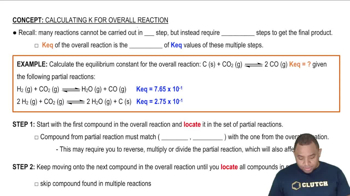Which of these two reactions would you expect to have the smaller orientation factor? Explain. a. O(g) + N2(g) → NO( g) + N(g) b. NO(g) + Cl2(g) → NOCl( g) + Cl(g)
Ch.14 - Chemical Kinetics
Chapter 14, Problem 77a
Consider this three-step mechanism for a reaction:
Cl2 (g) k1⇌k2 2 Cl (g) Fast
Cl (g) + CHCl3 (g) →k3 HCl (g) + CCl3 (g) Slow
Cl (g) + CCl3 (g) →k4 CCl4 (g) Fast
a. What is the overall reaction?
 Verified step by step guidance
Verified step by step guidance1
Identify the reactants and products in each step of the mechanism. For the first step, the reactants are Cl2 and the products are 2 Cl. In the second step, the reactants are Cl and CHCl3, and the products are HCl and CCl3. In the third step, the reactants are Cl and CCl3, and the product is CCl4.
Determine the intermediates by identifying species that appear as products in one step and reactants in another. Here, Cl and CCl3 are intermediates as they are produced in one step and consumed in another.
Cancel out the intermediates from the overall reaction. Since Cl and CCl3 are intermediates, they should not appear in the final balanced equation.
Write the overall reaction by combining the remaining reactants and products, ensuring to balance the equation. Start with the initial reactants that are not intermediates and include the final products that are not intermediates.
Check the stoichiometry of the final equation to ensure that the number of atoms of each element is the same on both sides of the equation.

Verified video answer for a similar problem:
This video solution was recommended by our tutors as helpful for the problem above.
Video duration:
2mWas this helpful?
Key Concepts
Here are the essential concepts you must grasp in order to answer the question correctly.
Reaction Mechanism
A reaction mechanism is a step-by-step description of how a chemical reaction occurs at the molecular level. It outlines the individual elementary steps that lead to the overall reaction, including the formation and consumption of intermediates. Understanding the mechanism helps in predicting the rate and outcome of the reaction.
Recommended video:
Guided course

Reaction Mechanism Overview
Elementary Steps
Elementary steps are the individual reactions that make up a reaction mechanism. Each step represents a single molecular event, such as the collision of reactants or the formation of products. The rate of the overall reaction is often determined by the slowest elementary step, known as the rate-determining step.
Recommended video:
Guided course

Reaction Mechanism Overview
Overall Reaction
The overall reaction is the net equation that summarizes the reactants and products of a chemical process, derived from the individual elementary steps. It reflects the stoichiometry of the reaction and provides insight into the conservation of mass. To find the overall reaction, one must combine the elementary steps while canceling out any intermediates.
Recommended video:
Guided course

Overall Reaction Equilibrium Constant
Related Practice
Textbook Question
Textbook Question
Consider this overall reaction, which is experimentally observed to be second order in AB and zero order in C: AB + C → A + BC Is the following mechanism valid for this reaction? AB + AB →k1 AB2 + A Slow AB2 + C → k2 AB + BC Fast
2
views
Textbook Question
Consider this three-step mechanism for a reaction:
Cl2 (g) k1⇌k2 2 Cl (g) Fast
Cl (g) + CHCl3 (g) →k3 HCl (g) + CCl3 (g) Slow
Cl (g) + CCl3 (g) →k4 CCl4 (g) Fast
b. Identify the intermediates in the mechanism.
Textbook Question
Consider this three-step mechanism for a reaction:
Cl2 (g) k1⇌k2 2 Cl (g) Fast
Cl (g) + CHCl3 (g) →k3 HCl (g) + CCl3 (g) Slow
Cl (g) + CCl3 (g) →k4 CCl4 (g) Fast
c. What is the predicted rate law?
1
views
